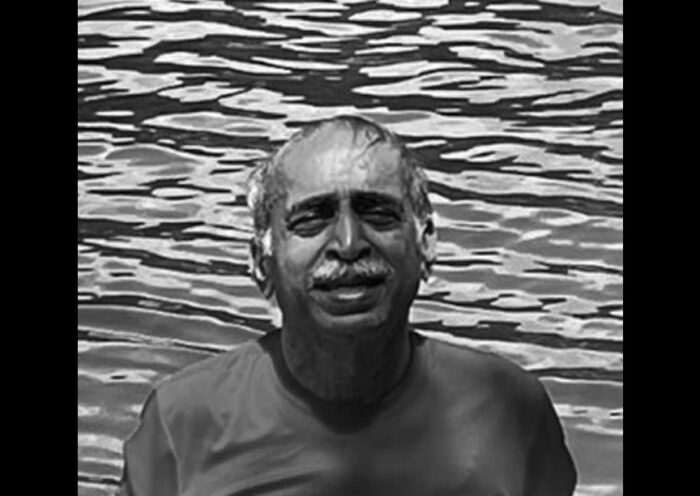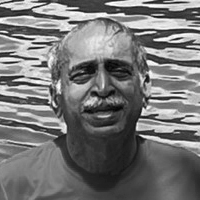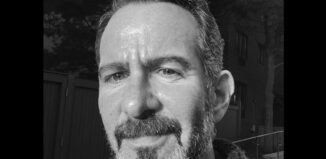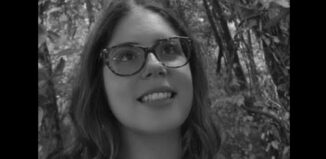Water
By Chetan Sankar
I was coming out of my near-death experience in the Cardia Intensive Care Unit at St. Joseph’s Hospital, Atlanta, and was feeling thirsty. Slowly, I opened my eyes completely and saw a nurse. I signaled to her to get me some water.
I looked around and saw my wife, Lakshmi.
“Hi, I am back,” I said.
She smiled and held my hand.
The nurse came back with a cup full of ice and gave me one ice cube. “This ice needs to last for an hour. You cannot drink water yet. Savor this.” I held it in my tongue and relished the feel of the ice. I twisted the ice with my tongue and savored it.
In another fifteen minutes, I wanted another cube of ice, but the nurse refused to give me one. She said, “wait an hour.”
I had taken the availability of water for granted and this incident made me reminisce about the role of water in my life from childhood to my senior years. When I performed research, I was surprised to find that currently one third of the world’s population doesn’t have access to potable water. What can we do to alleviate the suffering of these people?
Childhood
Where I grew up in rural South India, I lived in an arid climate: water was scarce, the rivers near homes were barren, and the riverbeds were filled with sand rather than water. There were no town-wide water supply or sewage removal operations. We lived in towns that were at least a hundred miles away from a nearby beach. I rarely saw any large bodies of water.
I remember a house where my mom had to keep all the food items in a cabinet that rested on four stone furniture cups. The cups were circular where the edges and the middle portions were at a height and a depression was formed between them. Water could be poured into the cup so that ants cannot get into the cabinet. At that time, milk was procured from local herdsman who will deliver fresh milk to home. My mom used to keep it in a dish and cover it with a lid. If we forgot to put the water into the cups, we will see ants floating on top of the milk in the dish. Frequently, my mom would curse since ants would have creeped in when the water dried up; she had to take out the floating ants and use the milk.
In the house, we drew water from a well using pulleys, rope, and a bucket. We used that water for both drinking and bathing. We used to drink water drawn from the wells assuming that it was drinkable. Little did we know that it might have been the reason for many of the diseases in our household.
During summer months, the water in the well would recede and we had to toil to get a bucket of water. In the monsoon months, the water would be near the top and we could easily draw the water. There were some years when monsoon failed leading to scarcity of water. Then, the well-diggers were in full demand, whose job was to deepen the wells further and find new sources of water.
The toilets were outhouses, which had cement platforms on all three sides about a foot from the floor. Typically, they were about 10 feet away at the back of the house. They didn’t have roofs but had a wooden door. Family members squatted on the platform and used a mug full of water to clean themselves. The waste stayed exposed to nature for a day or two until the restroom cleaner, typically someone from a lower caste, came with a basket to collect the waste and wash the outhouse, though they were never truly clean. The sun would dry the waste and it was difficult to clean it given that the cleaner only used a bucket or two of water. Given the stink, we would hurriedly perform our ablutions and come out from there.
When we traveled, roadside toilets were hard to find, and my mom had to hide behind bushes to urinate. Men urinated openly in India anywhere they wished. Feces from children and adults were left in the open, drawing mosquitoes and flies who pecked at them and spreading diseases among the people. It was a disgusting sight; we had to be careful in walking so that we did not accidently step on one.
We typically took a bath next to the well. We stripped to our undergarments and then drew water from the well and poured it on ourselves. Depending on the season and the depth at which the water was at the well, our baths might be very short. We used very thin towels to dry ourselves since the sun would do an excellent job of drying us quickly. Given the lack of water, very few people in the town knew swimming.
During the summer months, it would be so hot (possibly in the 100 degrees F) range, that we had to take a bath twice a day. The water level in the wells would be at a low point and we had to exert to pull the water out. As a young boy, I did not mind getting drenched in the rain as it was easier than drawing water from the well. My parents used to fuss about it, but it was a lot of fun for us youngsters.
When ladies or girls took baths near the well, they tied their pavadai (an undergarment like a skirt) to cover their breasts and took baths from the wells. Boys and men generally did not go to the back of the house when the ladies were taking a bath.
The clothes were washed next to the well. There was a washing stone that was kept nearby. This was just a large block of stone with a small slope so that we could squeeze and clean the clothes. We would draw a bucket of water, drop our clothes in the bucket, put some soap, squeeze, and clean the clothes using the stone, and then rinse them in the bucket of water. After that, we would hang the clothes on a clothesline that was a constant presence in our backyard. The clothes would dry in a couple of hours given the intensity of the sun. We had trouble cleaning our clothes only during the monsoon months when we had to dry them inside the house on clotheslines.
When I was about twelve, I visited our relatives in Chennai, I was fascinated to see the indoor plumbing. The the toilets were enclosed rooms where water came out of a pipe. These were Indian-style toilets where there was cement structure, and the toilet was integrated into the ground. We had to squat down on the toilet and then use water to flush the waste away inside the hole. The waste was collected in a tank that was at the front of the house. Sewage trucks would come once a month and pumps to remove the waste away from these tanks.
There were bathrooms where water would come out of taps and buckets would be placed under them. The buckets would have mugs that would hang on the side. People would have to strip to my undergarments and then use the mug to pour water on oneself. Typically, one stops a bath after using a bucket or two of water. There were no showerheads in these bathrooms.
Chennai is situated on the shores of the Bay of Bengal, a large body of water. In the evenings, I used to walk from my relative’s house to the Marina beach (about three miles away) and sit there for a period gazing at the unlimited expanse of water before my eyes. I wasn’t’ able to believe such a large expanse of water could be adjoining a large city. It was fun watching the waves and I used to wade into the water in my shorts. People wore modest clothes and you may see ladies standing in knee deep water with their saris pulled up.
The Bay of Bengal was ferocious, and it was not possible to wade much further than a few feet. But the beach was long and well kept. There would be many vendors that would sell their products and the crowd was intense. The noise from the vendors hawking the products would compete with the sound from the waves; the smell of deep fried pakodas and bondas would mix with the smell of fish; ships would be anchored a few miles away from the beach leading me to imagine the life of the sailors. I would walk barefoot on the sand enjoying the feeling of sand getting into my toes.
Adulthood
I joined my undergraduate college, Regional Engineering College, Trichy, when I was fifteen years old. Trichy was a large town that was served by the rivers Cauvery and Kollidam. The Kollidam river splits from the main branch of Cauvery River at the island of Srirangam and flows eastward into the Bay of Bengal. Even though the bridge to cross the river to get to Srirangam from Trichy would be long, the riverbed was mostly dry, and we could see sand everywhere. Only during monsoon season, the river will be flowing fully. People would dig the sand to get to the water. The municipality pumped water out of the river and supplied water to households in the city.
My college was located about ten miles away from the city in a rural area. It was a large campus. When I joined, it was three years old, and had an administrative building, a few departmental buildings, and a few hostels (dorms) to accommodate the students. The mess (cafeteria) for food was a separate structure. The staff and faculty members lived in residential units that were constructed inside the campus.
There was a large water tank where water from the underground (borewells) was pumped into and supplied the water to everybody on the campus. We had indoor plumbing and water was available in plenty. There was no filtration plant, and we drank water from the taps. There was no facility for obtaining hot water in the bathrooms. Since the temperature was mild even during winters, this did not pose any serious problems for us.
Some of my friends from North India who were used to getting hot water used to buy and hang a portable water coil to the side of the bucket and heat the water by plugging it in into a wall outlet. Even though this was a quick means to obtain hot water, frequently, we would get electric shocks if we touched the water or the coil without unplugging it.
I saw large bodies of water when I traveled to Kolkata to pursue my MBA from the Indian Institute of Management during 1971. This was the first time I had traveled out of my state to another state that was about 1,000 miles away. When I got on the train that would take me to Kolkata in two days, I bought a mud pot and filled it with water from the train station at Chennai. This kept the water cool during the hard and dusty two-day journey by train. The compartments were not air conditioned and the windows were kept open to facilitate air flow. We would feel the hot air coursing through the compartment during the daytime; it would cool down during the nighttime when we slept on the berths that were allotted to us. The water from the mud pot would condense and create a puddle on the floor of the compartment. Most people did not mind it since it cooled their feet in the hot weather.
Water was available in plenty at the dorms at my Institute. Unfortunately, the pipes had rusted, and we used to get red colored water spewing out of the showerheads. The concept of filtering water to drink was not common knowledge at that time. Therefore, frequently, we used to get stomach upsets from drinking the polluted water.
I saw the Hooghly River frequently since I crossed it either using a bridge or a boat from 1973 to 1977. I lived in South Kolkata and worked in a factory at Howrah on the other side of the Hooghly River. I had to take a bus from South Kolkata to the Howrah train station and then a local bus to the factory. Given the large population, all these buses were crowded, and one had to stand all the way. In the evenings, I took a bus from the factory to the riverfront, took a ferry, crossed the river, and took another bus from the Kolkata side to my home. Due to the humid and hot weather, most of the passengers would be smelling of sweat in the overcrowded buses.
I enrolled in a swim club in the Dhakuria lake, near where I lived in South Kolkata. It was a crowded pool and the instructor discouraged me from swimming since he felt I could not swim. That ended my swimming lessons in India.
Many parts of South Kolkata were below sea level and would get flooded during rainy seasons. The water would accumulate up to one’s knee level; I had to take my shoes in hand, roll up the pants, and cross this to get to my home. At other times, I used to hire hand rickshaws (small carts pulled by humans) who took me to the doorsteps. The rickshwallah (the person who pulled the cart) wore a dhoti folded up, ran bare feet, and were willing to cross the flooded streets for a few Rupees (local currency).
The Executive Director of the municipality visited our institute and talked to us about the difficulties in pumping water out of low-lying zones to the river. He also mentioned about the issues that arise when drinking water and sewage combine creating difficulties for the residents.
Hooghly river was a large body of water and the Howrah bridge to cross it was famous for its length and architecture. Ships used to sail under the bridge, and I used to wonder at this technological marvel. The water was used for all sort of purposes; drinking, cleaning, factories, etc., and was very polluted. When I walked near a ghat (and Kolkata had many of them where people could access the river using a series of steps), I saw people bathing in the river, cleaning their clothes, priests performing rituals, ladies putting flower garlands to worship the river, people fishing, and children loitering around the steps. The steps were not clean, and I had to be careful not to slip and fall into the river. The river itself was quite deep as Kolkata was a natural harbor. The rotting fish and floating flowers would combine to create a unique smell.
Lakshmi, my fiancé, was born and brought up in Kolkata. She used to have severe stomach pains due to drinking untreated water during her youth. But she did not realize the problem until much later in life. We married in March 1977, and I prepared for my travel to the USA in August to attend the University of Pennsylvania to obtain a Ph.D.
Studies and Career in the USA
Life at Philadelphia during the first five years was difficult since we lived on a student stipend and had no ability to bring any of the funds in India to the USA due to Indian government regulations. Our difficulties did not seem arduous due to the friendliness exhibited by my host family, relationships formed with other Indian friends, amazing mentorship by my advisor McDonough, and love from our family.
The Delaware and Schuylkill rivers encircled the city, and the fact that they never went dry fascinated me. This contrasted with many rivers in South India that were dry and became full only during monsoon season. We used to go on walks on the shores of the Delaware river and used to cross Schuylkill River to get into the downtown area.
Our old studio apartment had hot and cold water and the heating system was run using radiators that circulated hot water. The sewage system was connected to the city’s network. When we had an opportunity to travel to Manhattan, New York, I wondered at the ingenuity that led to constructing tunnels (such as Holland and Lincoln tunnels) under the rivers to access the island city.
The University of Pennsylvania had excellent gyms and they had two pools. I learned swimming in those pools by myself. Later, I took swimming classes in local pools when we lived in the suburbs of Philadelphia.
We moved to Matawan and Ocean Township in New Jersey from 1985 to 1989 when I worked for AT&T Bell Laboratories and Lakshmi worked for a private school. Lakshmi’s school was right on the boardwalk of the Atlantic Ocean. There were many rivers and lakes in the state, and it led to dense forests and green landscapes. There were many beaches near us, and we used to go for walks on the boardwalks occasionally. The Island Beach state park was about 30 minutes from our home, and we visited it during the summer months.
My friends from Philadelphia would visit us and we would end up going to this state park. I had to drive through many towns in New Jersey to access this beach and then cross a bridge across the bay to reach the island. As I drove through the towns, I saw houses that were built on the backwaters. Boats were docked on these narrow waterways, and I saw people navigate their boats through the rivers into the Atlantic Ocean.
The water would remain cold most of the year and we would waddle in and get out quickly to avoid the cold. Most of the people would be sunbathing and few would get into the water. It would be very hot for a few weeks and we all would rush to the beach. I have some amazing photos of our children waddling on the beach holding onto our and our friend’s hands. My love for water grew out of these activities.
We also visited the Sandy Hook beach that was north of us. Unfortunately, the water was not that clean in that beach. Once, we stopped in a beach in that area and saw rotten fish and animals washed ashore due to the pollution and environmental damage from the heavily populated North New Jersey and New York city. As we drove near Staten Island, the stink from the accumulated garbage dumps in that area would assail us and we had to close the windows of the cars. It was alleviated by the beautiful scenery that greeted me as we went through the tall Verrazano- Narrows bridge and saw the vast expanse of water on both sides.
We moved to Auburn, Alabama, during 1989 to start my academic job at Auburn University. During meetings with some of the senior faculty members, they mentioned that they had properties at Lake Martin, a lake about 30 miles away. They talked about the 750 miles of shoreline and the beauty of the land.
That piqued my curiosity and I eagerly accepted when one of them invited me to their lake home. I appreciated the serenity of that lake and the blue waters.
My two children and we explored that area further and camped at the Wind Creek State Park situated on this lake one summer and enjoyed the views. The campsites provided water and electricity. I had bought a tent, a dining tent, and sleeping bags for my family. It took some effort, but we were able to pitch the tent for all of us. The bathrooms and toilets were in a common area near the campsite. We enjoyed our stay there and Lakshmi cooked meals on a propane stove top. We played in the water, went for strolls in the trails, and befriended people who were nearby. After a few days’ stay, we packed our tents and returned home.
We felt comfortable with the people who lived near Lake Martin and started to look for properties to buy on the lakefront. Eventually, we bought a 3 bedroom, 2 bath cabin that needed repairs. The neighbors were retired people who were living full-time on the water. My son, Shiv, and I rented pontoon boats and jet skis from a nearby marina and explored the lake. We had a physical map of the lake and had no cell phones with GPS functionality. We had to navigate the different inlets, remember where we were, figure out how to come back if we were lost, and identify where our cabin was in the lake. There were many occasions when we would think we were approaching our house to find out that we were on the wrong inlet and had to retrace our way back to the main channel.
It provided a great bonding time for our family. My brothers and their families from the Northeast visited us occasionally and we took them around the lake. Many rich people who lived in Birmingham, AL, had estates at the lake and we used to gawk at them from the water. There were a few houses which were built on islands and that aroused our curiosity as to how those people lived there.
This was an artificial lake, in fact a reservoir, when Southern Company built a dam to produce electricity during the early 1900s. The level of the lake dropped by about 10 feet during winters and the lagoon where our cabin was had no water access during those months. Some of my colleagues had their homes in the deeper parts of the lake and we used to enjoy our visits with them.
Auburn University had an excellent swim team and had an Olympic size pool. I further refined my swimming in these pools and received training from outstanding coaches. Our children also learned swimming in these pools during the summer breaks.
Exploring Lakes in Georgia
During 2003, Lakshmi changed her to job to work in LaGrange, Georgia, adjoining the State of Alabama. We bought a house there so that she would be able to commute to her work and I can continue to work at Auburn, a 45-minute drive.
I wanted to learn more about operating boats and noticed that there was an organization called Coast Guard Auxiliary that offered training and camaraderie. I joined a local unit that operated out of West Point Lake, Georgia, and worked with experienced boaters. When I attended the first meeting, the other members were receptive and encouraged me to stay in the organization, even though I was the only brown person amidst the whites. Being a small group, it was easier for me to fit in and be accepted by others.
Being an auxiliarist meant that the Coast Guard might ask us to serve in case of emergencies in Coast Guard cutters; they also had the authority to deploy the boats belonging to the members for Coast Guard activities if need be. The Coast Guard was generally deployed in the coastal regions and there were no units other than local law enforcement officers responsible for keeping the lakes safe and navigable. The auxiliarists played an important role in helping the law enforcement and the Coast Guard in protecting the lakes and waterways in the country.
The flotilla commander invited me to join in a patrol in West Point Lake. I found that four of them had already launched the 26-foot Sea Ray Sun Dancer boat in the water. Gingerly, I walked on the deck and got into the boat. We spent about four hours in the water going from the dam to the Highland Marina. I understood the basics of the red and green buoys (“red, right, returning”) that mark the waterway. That lake with 525 miles of shoreline was managed by the US Corps of Engineers, and I did not see any houses next to the waterway. On enquiry, I found that it was to protect the houses from getting flooded and to preserve the natural beauty of the lake. We helped the park rangers by assisting any stranded boaters and teaching boating safety classes. I enjoyed the companionship of the members and joined them in many other patrols of the lake and taught boating safety classes.
In due course of time, after mastering the basics of boating, I qualified as a crew. That meant that I could assist the boat’s coxswain (a sailor who has charge of a boat and its crew and who usually steers) during patrols.
Steering a boat was relatively easy since it was like driving a car and there was a lot more leeway available in water compared to road when navigating the boat. The difficulty was in docking the boat; there was no brake on the boat, and one must gently ease the boat to the dock and angle it so that the crew could tie the boat to the cleats on the dock. We went on patrol for several nights to check whether the lights on the buoys were working or not and report it to the Corps. The Coast Guard reimbursed the coxswain for using his/her boat for official patrols and we had to learn to use the complex computer systems to request patrol orders and report completion of the patrols.
The flotilla conducted regular training on teamwork, navigation concepts, and reading maps (charts). We were also trained in how to perform search patterns and conduct rescue missions.
I became enthusiastic about buying a boat and requested Lakshmi to accompany me to the 2005 Birmingham Boat Show. We saw a beautiful yellow pontoon boat and bought it on the spot. I did not have a truck or a trailer and requested the dealer to deliver the boat to my lake cabin. He obliged me and sent a person to deliver the boat and train me in the basics of driving that boat. Wow, now we had a large 22-foot boat docked in our cabin with a trailer sitting in our yard.
It took several months for me to operate and use the pontoon boat effectively. In the meanwhile, winter approached and the water level in the lake receded. I was able to get a local marina to put my boat on the trailer, service it, and leave it at my cabin. I needed to learn how to tow the boat and therefore, I bought a Toyota Tacoma, a mid-size pickup truck.
I had to latch the trailer to the truck and drive in empty parking lots and learn the backing maneuver. I did not have a rearview camera in the truck and had to figure out how to back up the trailer in a straight line down a boat ramp. This is more of an art than science and my colleagues at the flotilla taught me some of the finer points in backing the trailer. The major issue is that one must rotate the steering wheel in the opposite direction of the backing maneuver; the angle of rotation determines how the trailer moves.
I went to the marinas to launch the boat at times where there were not many other boats so that I could take my time to do so. Even then, it was difficult to figure out exactly how much distance one must go in the water before you release the boat. Even now I admire those truck drivers who back up their vehicles up to loading ramps without breaking a sweat.
As I gathered confidence and experience in handling the boat, I trained to become a coxswain in my flotilla. A major task for this qualification was to perform stern tow and side tow. A stern tow meant that you tie the other boat to your stern using a line and tow it. The crew must listen to the appropriate instructions and ensure that the line does not get entangled in the propeller. A side tow required both the boats to be tied together on the side using four different lines. There was a sequence as to how to tie these lines and any error made it difficult to tow the other boat. We had to train together many times to master these techniques. When two boats are of uneven heights, this becomes a tricky maneuver. It is also possible to damage the side of the boats during the tow; one had to be careful to deploy the bumpers so that the damage is minimized.
Having mastered these techniques, I applied to be a coxswain. An experienced member of the auxiliary tested me, and I passed the requirements and was qualified as a coxswain. That provided me an opportunity to use my boat for patrols.
We were now living in LaGrange, GA, and having a boat at Lake Martin, about 70 miles away in a cabin, did not make much sense. Therefore, we sold our Lake Martin home and brought the boat back to LaGrange. Our homeowner’s association objected to us parking the boat in our driveway as it went against the covenants. I parked it at a local campsite and started looking for alternatives.
Lakshmi had a colleague living in Lake Harding, Alabama, about 30 miles away from LaGrange. We visited this area and found that this lake was managed by Georgia Power Company and most of the homes were leased from the power company for 15 years extendable to 30 years. After a six-month search, we bought a 4,200 sq ft house on the lakefront and obtained the lease from Georgia Power in 2007. It had a boat house, and I was able to dock the boat there. The Lake Martin cabin was no longer needed, and we sold it in 2008.
We decided to remodel our master bathroom on the second floor since the current one was small. We chose a closet and requested a contractor to create a bathroom there. He inspected the house and told us that the house was on a downward sloping hill and the current bathroom was at the highest point. Therefore, sewage easily flowed into the septic tank. If we wanted to move the bathroom to the larger closet further away from the front, sewage must move upstream and would need a pump. We agreed to the idea, and he put in a sewage pump next to the closet. Unfortunately, the pump leaked and failed often leading to water leaks and damage to the ceiling downstairs. The stink was unbearable whenever it broke. The water would leak through the floor and the drywall in the room below would collapse. We had to repair the pumping unit and ceiling multiple times.
After repeated repairs, we got frustrated and complained to the plumber. He said the only option is to move the pump outside the house, bury it, and run pipes to it so that the sewage would flow into the septic tank. We agreed and after an expensive repair and three days of work, the bathroom was usable. I learned a valuable lesson; it is difficult to fight nature and pump water upstream. Any failure of the pump leads to flooding.
This is a common problem in many cities around the world who are located at or below sea level. Any tornado, hurricane, or heavy rain floods the streets and causes considerable damage to property. Although pumps are deployed, they frequently don’t cope with torrential rains leading to severe flooding of homes and businesses.
As a coxswain, I used my boat to patrol both West Point Lake and Lake Harding along with my fellow auxiliarists. There were only a few boaters on these lakes most of the time; it got crowded during the holiday weekends, particularly during summer. I had an opportunity to witness and help with the July 4th fireworks on both lakes on multiple occasions. The major issue during these joyous weekends was boaters leaving their deck lights on during the nighttime thereby blinding the other boaters. We had to warn them to turn off these lights and use the navigation lights. In addition, the use of PFDs (personal flotation device, life preservers) was lax, and we had to ensure that those who rode the Jet Skis used them all the time.
I discovered that PFDs save lives; once you have it and are in the water, you stay afloat whatever happens. It is not possible to sink; therefore, there is no need to panic until help comes. Once, some of my relatives were visiting and we went on a ride around the lake in our pontoon boat. We had a jet ski and one of my brothers donned the PFD and tried to climb into the jet ski from the boat but fell in the water. He was scared and started shouting. Some of my relatives were ready to jump into the water to save him; I had to restrain them and tell them to desist.
We attached a rope to a float and threw it to him and asked him to hold it so that we could pull him into the boat. He was scared and started to put the rope around his neck. I had to tell him that nothing would happen to him as far as he had worn the PFD; he could not sink and therefore, there was no need for panic. In a few minutes, he calmed down, and we pulled him into the boat. Subsequently, he went on the jet ski and enjoyed that experience.
The best way to save a person stranded in water is to throw a float at them, ask them to hold it, and pull them in using the line. Jumping into the lake to save them might not be an appropriate strategy. People who assume they are drowning might use their adrenalin rush to pull any rescuer who jumps in down under the water; that is why it was recommended that we throw a float to them, they grab it, realize that they are not drowning, become normal, and then pull them into the boat.
Since these were artificial lakes that were created by releasing water and drowning the then existing buildings and roads, it was difficult to know where the water would be shallow or deep. It was important to have a good depth gauge and ensure that we stayed afloat and did not run aground.
Occasionally, we ran aground. Then, I had to lift the propeller up, push the boat away from the shallow portion using a paddle, and then get the boat away from that area. The boating community was friendly and respectful towards us even though we were one of the few minorities on the lake. I gained a lot of confidence in handling boats by belonging to the auxiliary.
During our patrols, my fellow auxiliarists and I noticed sewage from plants occasionally fed into lakes, leading to major pollution problems. This is a major problem in many states if it is not regulated by the local government. In 1990, I visited a steel plant to learn how to purify polluted water in Birmingham, Alabama. A lot of water was used to cool the hot metal during the forging process, and the polluted water had to be treated before being released into a river. I saw how the company worked valiantly to remove the pollutants and created a free-flowing, drinkable water stream using modern technologies. This showed me that although some of the water in the world is polluted, it is possible to clean and make it drinkable with the right resources.
My family spent several summers on beaches in Florida and in the Caribbean. I really enjoyed snorkeling. This required us to get in a boat, drive to a place where there are lots of coral reefs, then wear the snorkeling gear, jump into the water, float above the coral reefs, gawk at the variety of fish, sharks, turtles, tortoise, and other sea animals below us. It was an amazing moment where you see that there are so many creations in the world about which we pay scant attention.
I was in Hawaii one time and decided to try surfing. I went to a beach where they were offering surfing lessons. The young person gave me a board and taught me how to ride the waves. After thirty-minutes of trying and falling into the water, I asked him, “was there any simpler way?” He suggested lying on the board flat and surfing; I tried it and at least was able to surf a few times before I gave up.
In a beach, it is a lot of fun to get into the water and let the waves sweep past us. The undulating motion of the waves reminds me of how our lives have ebbs and valleys constantly. As we are relishing success, a defeat in another matter comes sweeping in and takes us to the bottom. Before we completely despair, a new positive wave lifts us up and we enjoy that moment.
Senior Years
The Near-Death Experience (NDE) during January 2019 shook my confidence and intention to continue with the rigorous boating activities. I retired from the auxiliary and sold our Lake Harding house. A person known to the realtor offered to purchase our boat and I sold it to them. My boating activities came to an end, but not my interest in the importance of water for everybody. Even though there is no large body of water next to Atlanta, I continue to enjoy water by participating in water aerobics at the local gym. We get into the pool and perform exercises, such as rigorous walking and moving various parts of the body. A trained instructor helps us perform these activities.
Having realized the importance of water, I have stopped drinking coffee, tea, or alcoholic drinks, since they are either stimulants or depressants. I keep a water bottle on my desk, on my bedroom nightstand, and in my car. When I travel, I ensure that I carry a water bottle with me. These steps ensure that I am hydrated constantly.
Water from the tap is drinkable in most towns and cities in the US. When I was at the hospital, once I was past the critical stage, the nurses insisted that I keep drinking water and urinate. In the hospital, they measured how much I urinated to ensure that there were no problems with my kidneys. Thankfully, drinkable water was available in plenty.
Water is an essential element of human living, and the nurses got me fresh water each time I needed it. Similarly, when I used the toilet, the wastewater and solids were sent to a central facility in the city where it was processed, and the water was purified and then mixed with regular water. Countless plumbers and engineers maintain the water’s purification and wastewater plants and ensure that the citizens in the city got potable water to drink and the waste in homes was taken away. They perform a heroic task without any complaints or fuss.
Did humans struggle to get water from their home generations back? I was astonished to see that using gravity, Romans built aqueducts in Spain, Italy, and other countries where they ruled (about 500 years, from 312 B.C.E. to C.E. 226), to bring water to homes using gravity[i]. I had seen aqua duct systems in palaces in Rajasthan, India, so that the royalty had access to water. I assumed that with all the modern technologies that are available to us, clean water is accessible to all.
Availability of Potable Water for Everybody
When I performed research, I found that potable water is not that widely available. About 71 percent of the earth’s surface is covered in water, but its availability for drinking is limited to where we live and the technologies that are adopted by the community to purify and bring it to people’s homes.
According to an 2022 UN report[ii], one in three people does not have access to safe drinking water, two out of five people do not have a basic hand-washing facility with soap and water, and more than 673 million people still practice open defecation. Women and girls are responsible for water collection in 80 percent of households without access to water on the premises. More than 80 percent of wastewater resulting from human activities is discharged into rivers or the sea without any pollution removal. Floods and other water-related disasters account for 70 percent of all deaths related to natural disasters.
What can we do to change some of these conditions? I identified several organizations that are leading efforts to change conditions and I have joined and/or donated to them to help alleviate some of the misery that one third of the world population suffers from.
Water for People[iii] has provided 4.7 million people with reliable water supply around the world. They focus on things like protecting water supplies, training mechanics, and establishing supply chains for parts in addition to drilling wells and installing pumps. It means they think about long-term projects like advocating for national water policies and creating local water and sanitation utilities. It accepts donations and has the ability for us to volunteer on fund raising and providing technical assistance.
Charity: Water[iv] works with local organizations to build sustainable, community-owned water projects around the world. It accepts donations to fund the projects.
World Water Relief[v] installs water filtration systems, local training on maintaining the system, ongoing maintenance, and hygiene education. This education is critical to help prevent the spread of waterborne disease. An estimated 1/3 of school-aged children in the developing world are infested with intestinal worms. Not only do these illnesses rob children of school attendance and achievement, but they are also underlying causes of malnutrition and stunting.
UN’s Sustainable Development Goal 6 calls to ensure universal and equitable access to safe and affordable drinking water, sanitation, and hygiene for all by 2030. “Access to clean water changes everything; it is a stepping-stone to development. When people gain access to clean water, they are better able to practice good hygiene and sanitation. Children enjoy good health and are more likely to attend school. Lives of women and children improve. Parents put aside their worries about water-related diseases and lack of access to clean water. Instead, they can water crops and livestock and diversify their incomes. Communities develop and thrive.”
Water.org is a global nonprofit organization working to bring water and sanitation to the world[vi]. They help people get access to safe water and sanitation through affordable financing, such as small loans. They give our everything every day to empower people in need with these life-changing resources – giving women hope, children health and families a bright future. They work with local agencies/ municipalities to implement solutions.
Water gets into our system, water gets out of our system, and the water we drink must be processed so that it is safe for consumption. In any part of the world, there is a need to obtain clean drinkable water and efficient processing of waste. The water we drink comes from water our ancestors drank, their waste was processed by earth, and water was regenerated to keep us alive. Similarly, the water we drink and the water in our waste will subsequently be used by our succeeding generation. It is critical to recirculate the wastewater so that it is free of toxins for those who need it next.
I am saddened to note that the lack of potable water which I experienced as a young adult is common to 33% of the world population today. I hope and pray that in the next few decades people around the world will have their need for potable water and sewage treatment met adequately.
[i] https://education.nationalgeographic.org/resource/roman-aqueducts/
[ii] UN Department of Economic and Social Affairs, “Ensure Availability and Sustainable Management of Water and Sanitation for All,” https://sdgs.un.org/goals/goal6
[iii] https://www.waterforpeople.org/the-progress/
[iv] https://www.charitywater.org/our-work
[v] https://www.worldwaterrelief.org/why-wash-2/
[vi] https://water.org/about-us/?_gl=1*pnttp*_up*MQ..&gclid=CjwKCAjw4ZWkBhA4EiwAVJXwqQxOpEAm9VLhmSlk7Rw1SGP4Hdw9VWuBvYavulEBBjc_mNt_dMmiRxoCPmIQAvD_BwE
BIO
Chetan S Sankar holds a doctorate in the information systems area and was a professor and researcher in this field for thirty-five years. He is a member of the Atlanta Writer’s Conference and coordinates the memoir critique group. Attending the Creative Writing Program at Emory University and receiving critiques from the memoir group have helped him write this article. He lives in Avondale Estates, Georgia with his wife. He spends his time playing with and learning from his four grandchildren. His website is at www.chetansankar.com.



















